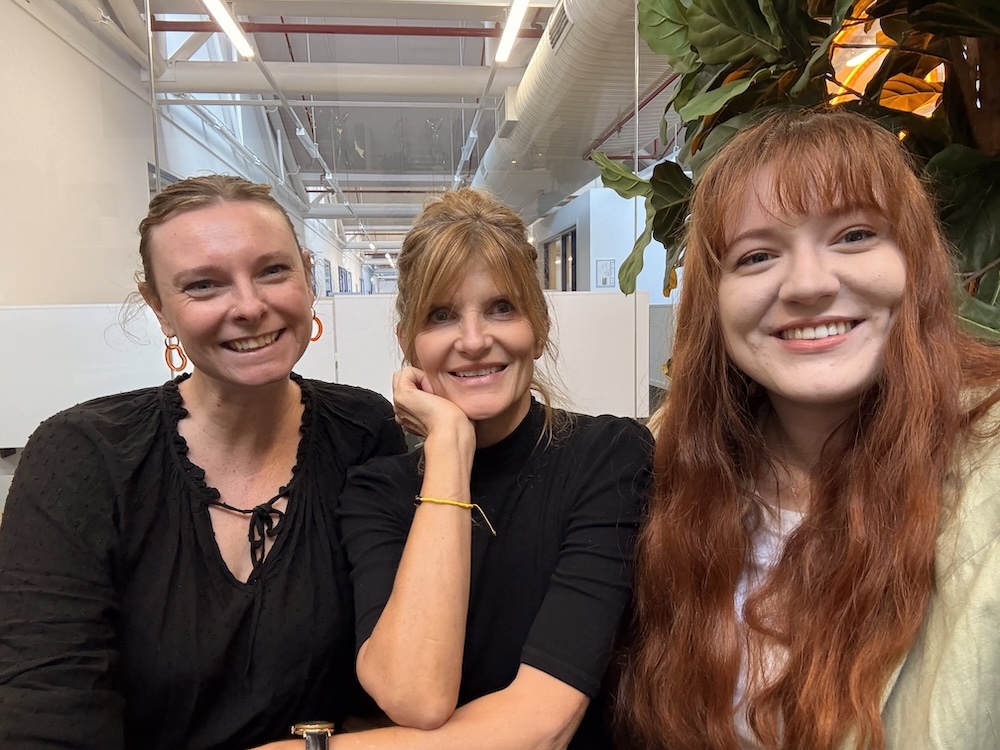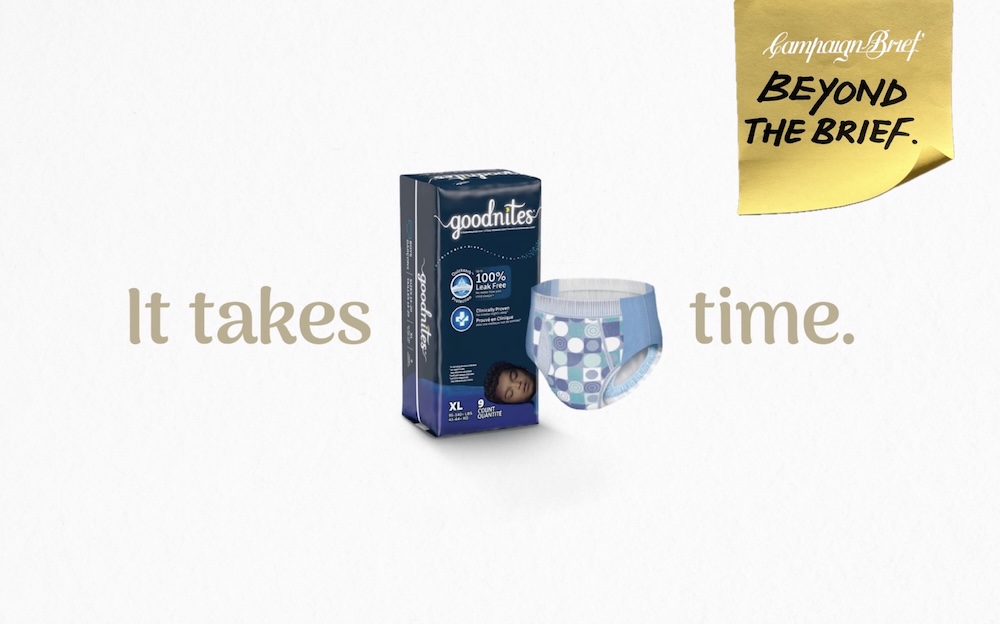Beyond the Brief: Eardrum trio unpacks Goodnites’ global audio campaign ‘It Takes Time’

In the debut edition of Campaign Brief’s new series, Beyond the Brief, we speak with Eardrum’s senior production team, Senior Producer Tess Waldron, Head of Casting Kate Wylie, and Junior Producer Emily Burns, about the making of Goodnites’ new global audio campaign ‘It Takes Time’, created with FCB Aotearoa. From unconventional casting and AI voice cloning to crafting comedy through sound alone, the trio breaks down how smart creative thinking made the tech work.
Can you walk us through how Eardrum pulled the voices together—from casting the kids and adult comedians to stitching it all together using AI?
Kate Wylie: Voice casting is an integral part of Eardrum’s production process, so for a global campaign like this I would normally scour the planet for the most talented child actors. But as the scripts evolved, I knew we needed to take a more unconventional approach using some of the new tools available to us.
I started by identifying the perfect comedy architype for each script:
• Getting a Degree = brash Bostonian
• Getting Over an Ex = world-weary New Yorker
• Moving Out = Melodramatic Valley Girl
The next step was to cast adult comedians and actors who could best deliver that specific style.
Once Ralph had worked his directing magic with the adult talent, we auditioned a wide range of children and selected three young voices, each with unique characteristics and vocal textures.
AI technology was utilised to sample each child’s voice, creating a synthetic version we could use to ‘perform’ our adult recordings.
From there, Ralph took a meticulous, almost surgical approach, cutting, layering, pitch shifting and fine-tuning to ensure the final performances had genuine emotional depth and humour.
Comedy can be hard to nail in audio, let alone with AI. What was the process like to get the performances feeling natural and genuinely funny?
Tess Waldron: Comedy relies on surprise, and for surprise you need authenticity. If the performances were too big, too flat or the voices sounded unnatural, the listener would smell a rat.
The scripts were brilliant but full, so timing and rhythm were crucial. Through trial and error, the team quickly learnt that certain vocal elements like tempo and pitch could easily skew unnatural, often veering into “everyone sounds like they’re on helium” territory.
To counter this, Ralph directed the adult comedians to slow down and lean into their character personas with exaggerated nuance. This gave us more control in post-production and ensured we could emphasise all the comedic beats.
Were there any unexpected technical or creative hurdles that came up while creating the AI voices?
Tess Waldron: “As an audio specialist, many of the hurdles are self-imposed to keep the standards high. We weren’t prepared to compromise on the performance of a single word, which meant doing a few pick-ups throughout the process.
A major hurdle was navigating the ethical considerations as some VO artists were understandably hesitant about AI technology. I dived into the legal and ethical side of things and made transparency a priority. The process was fully compliant with legal and ethical standards, but a few performers didn’t want to participate.
The approach was never about replacing actors, in fact it led to twice as many performers being paid.”
Emily Burns: “On the technical side, it was a very steep learning curve with hours spent testing voice clones, blending AI with real voices, and adjusting pitch, emotion, and timing to make performances feel natural. One creative challenge was learning how subtle changes in the way the voices were blended could make a huge difference to the comedic timing.
In the end, we created something that felt authentic and demonstrated how AI can enhance the creative process without replacing it.

You’ve mentioned that AI can sometimes take away from the craft. What made it work for the idea this time, rather than against it?
Tess Waldron: No matter how gifted an actor they are or how good Ralph’s direction is, a nine-year-old simply doesn’t have the emotional maturity and life experience needed to capture the subtlety and comedic timing within these stories.
To get the most out of the concept and the great scripts, we embraced the technology and as a result had the cutest sounding kids perform scripts way beyond their years.
While AI is usually used to cut corners, speed up the process or save money, on this occasion it made the result ten times better.
How did you approach the sound design side of things? Was it all about keeping things simple to let the voices shine, or was there more to it?
Emily Burns: Ralph’s brief was to imagine each child sitting on the stage of a small, intimate jazz club. A band accompanying them as they tell the most compelling stories about their parents. That image really guided our approach to the understated sound design.
I searched the libraries for tracks that would amplify that melancholic feeling without overwhelming the storytelling. We leaned into jazz underscores that were subtle, expressive, and emotionally rich.
What excites Eardrum about working in audio that other mediums just don’t do the same way?
Kate Wylie: The freedom and variety we enjoy in audio is unlike any other medium. We’re rarely restricted by budgets, the best actors on the planet are just a studio link away and we can obsess and nerd out until every detail matches the world in our head. What’s not to love!
How do you see the use of AI evolving in the audio space—from a creative, not just technological, perspective?
Tess Waldron: It depends if your business model is based on making things fast and cheap or making things great. So far, the pitch of every AI based voice, music or audio creative business is based on cost savings and speed. It’s never about making the work more effective.
Which is why right now AI is excelling in the disposable shallow end of the audio world. It’s a godsend for those making ads with zero creativity, cliché voices and forgettable music, because now they can get all that faster and at a fraction of the price.
Of course, the rate of improvement in this space is staggering, but people don’t listen to ads they listen to what interests them. That still requires a big idea based on a killer insight and an experienced audio director to bring it to life in an authentic compelling way.
This Goodnites campaign shows it’s possible to elevate a great idea by using AI. But for now, it’s the exception rather than the rule.
Client: Kimberly-Clark
Agency: FCB Aotearoa
Chief Creative Officer: Leisa Wall
Copywriter: Gaetano Perry
Art Director: Tim Thach
Production Company: Eardrum
Director: Ralph van Dijk
Producer: Tess Waldron
Voice Casting: Kate Wylie
Recording Studio: MassiveMusic
Sound Design: Eardrum
Sound Engineers: Myles Lowe, Madelyn Tait & Paul Taylor
Soundtrack: c/o Audio Network
Media Agency: Publicis Media Chicago
Pictured (L-R): Tess Waldron, Senior Producer; Kate Wylie, Head of Casting, and Emily Burns, Junior Producer
Want to leave a comment? Share your thoughts below, making sure to include your full name and email address. If you have a news tip or story idea, please feel free to email ricki@campaignbrief.com.
